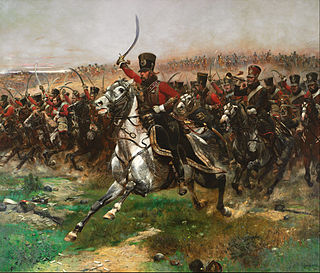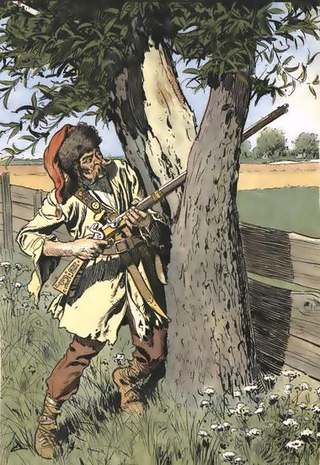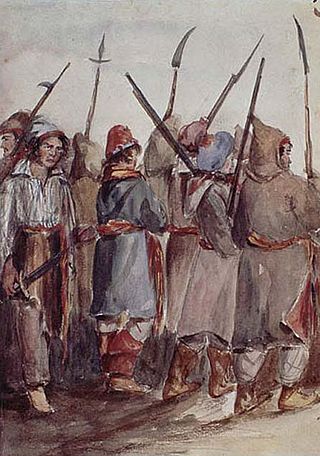
An army, ground force or land force is an armed force that fights primarily on land. In the broadest sense, it is the land-based military branch, service branch or armed service of a nation or country. It may also include aviation assets by possessing an army aviation component. Within a national military force, the word army may also mean a field army.

The British Army is the principal land warfare force of the United Kingdom, British Overseas Territories and Crown Dependencies, a part of the British Armed Forces along with the Naval Service and the Royal Air Force. As of 1 January 2024, the British Army comprises 75,166 regular full-time personnel, 4,062 Gurkhas, 26,244 volunteer reserve personnel and 4,557 "other personnel", for a total of 110,029.

Historically, cavalry are soldiers or warriors who fight mounted on horseback. Until the 20th century cavalry were the most mobile of the combat arms, operating as light cavalry in the roles of reconnaissance, screening, and skirmishing in many armies, or as heavy cavalry for decisive shock attacks in other armies. An individual soldier in the cavalry is known by a number of designations depending on era and tactics, such as a cavalryman, horseman, trooper, cataphract, knight, drabant, hussar, uhlan, mamluk, cuirassier, lancer, dragoon, or horse archer. The designation of cavalry was not usually given to any military forces that used other animals for mounts, such as camels or elephants. Infantry who moved on horseback, but dismounted to fight on foot, were known in the early 17th to the early 18th century as dragoons, a class of mounted infantry which in most armies later evolved into standard cavalry while retaining their historic designation.

Infantry is a specialization of military personnel who engage in warfare combat. Infantry generally consists of light infantry, irregular infantry, heavy infantry, mountain infantry, motorized infantry, mechanized infantry, airborne infantry, air assault infantry, and naval infantry. Other types of infantry, such as line infantry and mounted infantry, were once commonplace but fell out of favor in the 1800s with the invention of more accurate and powerful weapons.

Medieval warfare is the warfare of the Middle Ages. Technological, cultural, and social advancements had forced a severe transformation in the character of warfare from antiquity, changing military tactics and the role of cavalry and artillery. In terms of fortification, the Middle Ages saw the emergence of the castle in Europe, which then spread to the Holy Land.

A militia is generally an army or some other fighting organization of non-professional and/or part-time soldiers; citizens of a country, or subjects of a state, who may perform military service during a time of need, as opposed to a professional force of regular, full-time military personnel; or, historically, to members of a warrior-nobility class. When acting independently militias are generally unable to hold ground against regular forces; militias commonly support regular troops by skirmishing, holding fortifications, or conducting irregular warfare, instead of undertaking offensive campaigns by themselves. Local civilian laws often limit militias to serve only in their home region, and to serve only for a limited time; this further reduces their use in long military campaigns. Militias may also, however, serve as a pool of available manpower for regular forces to draw from, particularly in emergencies.

A fyrd was a type of early Anglo-Saxon army that was mobilised from freemen or paid men to defend their Shire's lords estate, or from selected representatives to join a royal expedition. Service in the fyrd was usually of short duration and participants were expected to provide their own arms and provisions.

The Songhai Empire was a state located in the western part of the Sahel during the 15th and 16th centuries. At its peak, it was one of the largest African empires in history. The state is known by its historiographical name, derived from its largest ethnic group and ruling elite, the Songhai people. Sonni Ali established Gao as the empire's capital, although a Songhai state had existed in and around Gao since the 11th century. Other important cities in the kingdom were Timbuktu and Djenné, where urban-centred trade flourished; they were conquered in 1468 and 1475, respectively. Initially, the Songhai Empire was ruled by the Sonni dynasty, but it was later replaced by the Askia dynasty (1493–1591).

The French Army, officially known as the Land Army, is the principal land warfare force of France, and the largest component of the French Armed Forces; it is responsible to the Government of France, alongside the French Navy, French Air and Space Force, and the National Gendarmerie. The Army is commanded by the Chief of Staff of the French Army (CEMAT), who is subordinate of the Chief of the Defence Staff (CEMA), who commands active service Army units and in turn is responsible to the President of France. CEMAT is also directly responsible to the Ministry of the Armed Forces for administration, preparation, and equipment.

Skirmishers are light infantry or light cavalry soldiers deployed as a vanguard, flank guard or rearguard to screen a tactical position or a larger body of friendly troops from enemy advances. They are usually deployed in a skirmish line, an irregular open formation that is much more spread out in depth and in breadth than a traditional line formation. Their purpose is to harass the enemy by engaging them in only light or sporadic combat to delay their movement, disrupt their attack, or weaken their morale. Such tactics are collectively called skirmishing.
Ancient warfare is war that was conducted from the beginning of recorded history to the end of the ancient period. The difference between prehistoric and ancient warfare is more organization oriented than technology oriented. The development of first city-states, and then empires, allowed warfare to change dramatically. Beginning in Mesopotamia, states produced sufficient agricultural surplus. This allowed full-time ruling elites and military commanders to emerge. While the bulk of military forces were still farmers, the society could portion off each year. Thus, organized armies developed for the first time. These new armies were able to help states grow in size and become increasingly centralized.

Irregular military is any non-standard military component that is distinct from a country's national armed forces. Being defined by exclusion, there is significant variance in what comes under the term. It can refer to the type of military organization, or to the type of tactics used. An irregular military organization is one which is not part of the regular army organization. Without standard military unit organization, various more general names are often used; such organizations may be called a troop, group, unit, column, band, or force. Irregulars are soldiers or warriors that are members of these organizations, or are members of special military units that employ irregular military tactics. This also applies to irregular infantry and irregular cavalry units.

The history of the British Army spans over three and a half centuries since its founding in 1660 and involves numerous European wars, colonial wars and world wars. From the late 17th century until the mid-20th century, the United Kingdom was the greatest economic and imperial power in the world, and although this dominance was principally achieved through the strength of the Royal Navy (RN), the British Army played a significant role.
The limitanei, meaning respectively "the soldiers in frontier districts" or "the soldiers on the riverbank", were an important part of the late Roman and early Byzantine army after the reorganizations of the late 3rd and early 4th centuries. The limitanei, unlike the Comitatenses, palatīni, and Scholae, garrisoned fortifications along the borders of the Roman Empire and were not normally expected to fight far from their fortifications.

The Battle of Muret, fought on 12 September 1213 near Muret, 25 km south of Toulouse, was the last major battle of the Albigensian Crusade and one of the most notable pitched battles of the Middle Ages. Although estimates of the sizes of the respective armies vary considerably even among distinguished modern historians, it is most well known for a small force of French knights and crusaders commanded by Simon de Montfort the Elder defeating a much larger allied army led by King Peter II of Aragon and Count Raymond VI of Toulouse.

Warfare occurred throughout the history of Ancient Greece, from the Greek Dark Ages onward. The Greek 'Dark Ages' drew to an end as a significant increase in population allowed urbanized culture to be restored, which led to the rise of the city-states (Poleis). These developments ushered in the period of Archaic Greece. They also restored the capability of organized warfare between these Poleis. The fractious nature of Ancient Greek society seems to have made continuous conflict on this larger scale inevitable.
The history of the Australian Army is the culmination of the Australian Army's predecessors and its 120-year modern history. The Army has its origins in the British Army and colonial military forces of the Australian colonies that were formed prior to the Federation of Australia. These were gradually united into federal units between 1899 and 1903; thus forming the beginning of the Australian Army. The colonial forces were combined and formed the basis of the new army, when the Commonwealth of Australia was founded on 1 January 1901. The modern history of the Army began with its founding at the start of the 20th century as the colonial armies were officially united as the Commonwealth Military Forces. In 1916 the title 'Australian Military Forces' was adopted and remained its official name until 1980, after which it became known as the Australian Army.
The military of ancient Rome was one of largest pre-modern professional standing armies that ever existed. At its height, protecting over 7,000 kilometers of border and consisting of over 400,000 legionaries and auxiliaries, the army was the most important institution in the Roman world. According to Titus Livius, one of the more illustrious historians of Rome over the centuries, the military was a key element in the rise of Rome over "above seven hundred years" from a small settlement in Latium to the capital of an empire governing a wide region around the shores of the Mediterranean, or, as the Romans themselves said, mare nostrum, "our sea". Livy asserts: yes

The Scots Army was the army of the Kingdom of Scotland between the Restoration in 1660 and the Acts of Union of 1707. A small standing army was established at the Restoration, which was mainly engaged in opposing Covenanter rebellions and guerrilla warfare pursued by the Cameronians in the East. There were also attempts to found a larger militia. By the Glorious Revolution in 1688–89 the standing army was over 3,500 men. Several new regiments were raised to defend the new regime and, although some were soon disbanded several took part in William II's continental wars. By the time of the Act of Union in 1707, the army had seven units of infantry, two of horse and one troop of Horse Guards. Early units wore grey, but adopted red like the English army after 1684. New Scottish and particularly Highland regiments would be raised from the 1740s, some of which had a long history within the army.

The Royal Guernsey Militia has a history dating back 800 years. Always loyal to the British Crown, the men were unpaid volunteers whose wish was to defend the Island of Guernsey from foreign invaders.
















